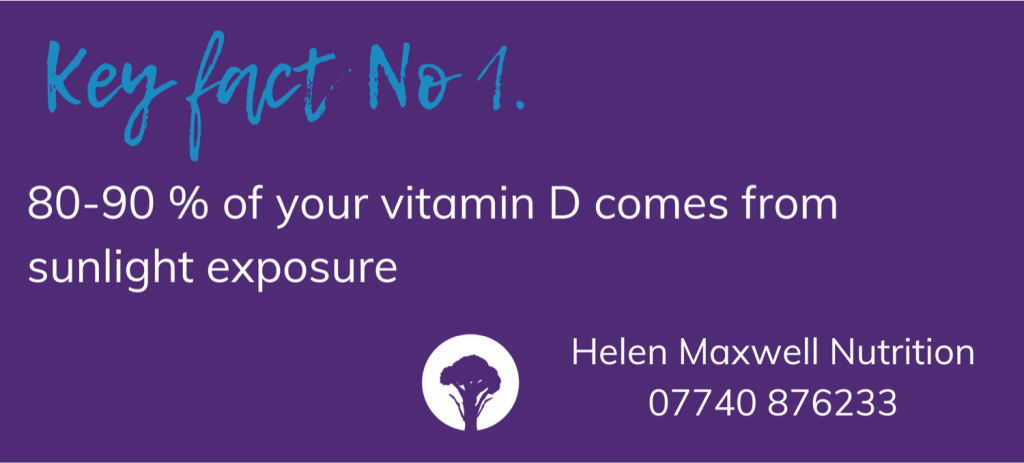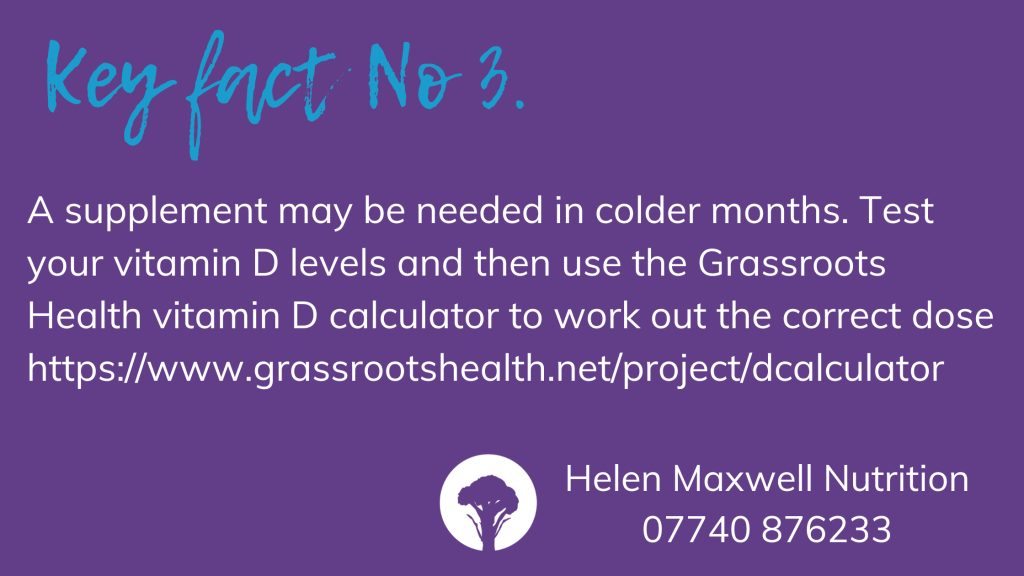
There are two major forms of vitamin D from two different sources.
In the UK our main dietary sources of vitamin D are food of animal origin, foods fortified with vitamin D and supplementation. Naturally rich food sources include egg yolk and oily fish such as salmon, mackerel, herring and sardines.

We probably absorb between 62 to 92% of our dietary vitamin D. It is fat soluble and absorbed in the small intestine from where it is transported via the lymph into the circulation. Vitamin D produced under the skin enters the fluid between our cells (extracellular) before defusing into the circulation and being transported to the liver.
| Food sources | International Units (IU) |
| Salmon 140g | 408 |
| Sardines canned 140g | 184 |
| Mackerel 140g | 476 |
| Mushrooms 80g (enriched) | 128 |
| 1 egg | 64 |
| Tuna 140g | 60 |
| Beef mince 100g | 24 |
| Lamb 90g | 20 |
| Butter 10g | 4 |
Total vitamin D production depends on a combination of factors:
The body appears to store vitamin D in adipose tissue (fat cells) and possibly muscle tissue. Studies suggest that levels of vitamin D decline as our body mass index (BMI) increases, and increase as BMI decreases. However the ability of the body to access these stores is unclear and it may be sequestered rather than stored.
There are in fact, a whole lot of factors that affect how much vitamin D our bodies can make including:
The main role of vitamin D is to help regulate the absorption and metabolism of calcium and phosphorus from the gut. To a lesser extent it also regulates magnesium absorption.
Vitamin D is therefore vital for bone mineralisation, bone growth and bone health. Without it bones will be soft, malformed, and unable to repair themselves normally. This results in the disease called rickets in children and osteomalacia in adults. Vitamin D also plays an important role in musculoskeletal health and neuromuscular function because of its’ role in calcium homeostasis.
However evidence is emerging of other roles for vitamin D including:
Both vitamin D2 and vitamin D3 are converted by the liver to 25-hydroxyvitamin D written in shortform as 25(OH)D and then to the active hormone 1,25 dihydroxyvitamin D. Tests measure 25(OH)D to estimate the status of vitamin D in the body because it is the most useful indicator. It remains in the blood longer and is present at much higher concentrations than the active form.

The National Osteoporosis society (NOS) guidelines (UK, 2013) and the Institute of Medicine (US) classify vitamin D results as follows:
The Scientific Advisory Committee Report (SACN) report (2016) considers levels in the UK below 25 nmol/L to be inadequate with an increased risk of rickets and osteomalacia.
However the Endocrine Society Task Force concluded 50 nmol/L as the cut off for deficiency and recommended that concentration “should exceed 75 nmol/L” for maximum benefit on calcium, bone and muscle metabolism. Other researchers have proposed thresholds between 50-120 nmol/L to reduce the risk of adverse non-skeletal outcomes.
Dr Damien Downing, president of the British Society for Ecological Medicine and vitamin D expert, recommends a vitamin D blood level of at least 75 nmol/L for immune support and levels over 100 nmol/L to lower your risk of cancer and autoimmune disease. Grassroots Health (vitamin D global expert Group) suggest anything below 100 nmol/L is inadequate and recommend optimum levels of 100-150 nmol/L.

Your magnesium and vitamin K2 intake can also influence your vitamin D absorption. Magnesium is required for the conversion of vitamin D into its active form. If your magnesium level is too low you may store vitamin D in its inactive form.
Low blood levels of vitamin D may mean that you are not getting enough exposure to sunlight or enough dietary intake or that there is a problem with its absorption from the intestines.
In the UK most people should be able to obtain enough vitamin D from sunlight from the end of March to the end of September.
During autumn and winter as many of us don’t get enough sun exposure a supplement may be required. The best way to determine your requirement is to measure your vitamin D (https://www.vitamindtest.org.uk/) level and then use the Grassroots vitamin D calculator to work out the correct dose. https://www.grassrootshealth.net/project/dcalculator.

Grassroots Health also suggest taking 600mg of magnesium and supplemental K2 of 90 mcg for women and 120 mcg for men daily. This helps to support bioavailability of your vitamin D as well as conversion to the active form.
Elderly people, those with darker skin tones, overweight or obese individuals or those exposed to limited sunlight have a much higher risk of becoming deficient. The Department of Health and Social Care recommends a daily supplement containing 10 micrograms (400IU) of vitamin D for higher risk groups like these.
You can also get some idea of where your level might be by using the D Minder Pro app from the App Store. This app is expertly designed to help you track and manage your vitamin D levels. It also provides other useful data related to your geographical location.
Official recommendations on how much to supplement vary widely. In the UK it's 400 IU (international units) or 10mcg (micrograms). The EU and many countries go for 400-600 IU, the exception is Italy's 2000 IU (50 mcg), in the USA its1000 IU (25 mcg). Some vitamin D researchers and experienced clinicians, such as Professor Hollick, recommend 4000 to 5000 IU (125 mcg) for daily maintenance. A general guideline for adults over the age of 18 is between 50-100 mcg (2000 – 4000IU) for the colder months. It is recommended to work with a healthcare practitioner before supplementing at these levels.
Clinicians usually recommend vitamin D3 for supplementation as D2 isn’t so effective at raising vitamin D levels in the blood.

Commercially vitamin D is synthesised by UVB irradiation of 7DHC (from sheep wool) and ergosterol (from fungi). Prolonged sunlight doesn’t cause excess production but high dose supplementation can be toxic and can cause hypercalcaemia (soft tissue deposition of calcium). High levels will usually reflect supplement intake.
To evaluate how your sun exposure and/or supplement dose is working for you it’s a good idea to re measure your vitamin D level after three to six months.
Alliance for Natural Healthhttps://www.anhinternational.org/campaigns/test-take-vitamin-d/
Bikle, D.D. (2009) Vitamin D and immune function: understanding common pathways; Curr Osteoporos Rep; Jul; 7(2); pp.58-63. doi: 10.1007/s11914-009-0011-6.
Haddad, J.G. et. al (1993) Human plasma transport of vitamin D after its endogenous synthesis; Journal of Clinical Investigation; June; 91(6) pp.2552-5. doi: 10.1172/JCI116492.
Holick, M.F. (2011) Evaluation, treatment, and prevention of vitamin D deficiency: an Endocrine Society clinical practice guideline; J Clin Endocrinol Metab; July; 96(7); pp.1911-30. doi: 10.1210/jc.2011-0385.
Ovesen, L. et. al (2003) Geographical differences in vitamin D status, with particular reference to European countries; Proceedings of the Nutrition Society; Symposium on optimal nutrition for osteoporosis prevention; 62 pp. 813-821.
SACN (2016) Vitamin D and Health; The Scientific Advisory Committee on nutrition; Available from https://www.gov.uk/government/groups/scientific-advisory-committee-on-nutrition. (SACN)




